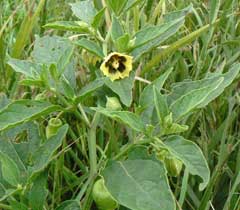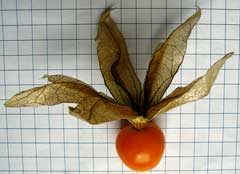 |
|
http://commons.wikimedia.org/wiki/User:MONGO |
 |
| http://commons.wikimedia.org/wiki/User:Matthieu_Godbout |
Translate this page:
Summary
Physical Characteristics

 Physalis heterophylla is a PERENNIAL growing to 0.9 m (3ft) by 1 m (3ft 3in).
Physalis heterophylla is a PERENNIAL growing to 0.9 m (3ft) by 1 m (3ft 3in).
See above for USDA hardiness. It is hardy to UK zone 8. It is in flower from July to September. The species is hermaphrodite (has both male and female organs) and is pollinated by Insects.
Suitable for: light (sandy), medium (loamy) and heavy (clay) soils and prefers well-drained soil. Suitable pH: mildly acid, neutral and basic (mildly alkaline) soils. It can grow in semi-shade (light woodland) or no shade. It prefers dry or moist soil.
UK Hardiness Map
US Hardiness Map
Synonyms
P. ambigua.
Plant Habitats
Cultivated Beds;
Edible Uses
Edible Parts: Fruit
Edible Uses:
Fruit - raw or cooked[46, 105, 161]. Quite nice raw though rather small[K], the fruit can also be made into pies, jams, sauces etc[183]. Pectin or pectin-rich fruit should be added if the fruit is used in jams and preserves[183]. The fruit can also be dried, ground into a meal and added to flour for making bread etc[183]. The plant conveniently wraps up each fruit in its own 'paper bag' (botanically, the calyx) to protect it from pests and the elements. This calyx is toxic and should not be eaten.
References More on Edible Uses
Medicinal Uses
Plants For A Future can not take any responsibility for any adverse effects from the use of plants. Always seek advice from a professional before using a plant medicinally.
Antitumor Diuretic Poultice Urinary
The seed is considered to be beneficial in the treatment of difficult urination, fever, inflammation and various urinary disorders[222]. A tea made from the leaves is used in the treatment of headaches and as a wash for burns and scalds[222]. A poultice of the leaves and roots is applied to wounds[222]. An infusion of the leaves and roots is used as a wash on scalds, burns and VD sores[257]. Compounds in the plant are being investigated for antitumor activity[222].
References More on Medicinal Uses
The Bookshop: Edible Plant Books
Our Latest books on Perennial Plants For Food Forests and Permaculture Gardens in paperback or digital formats.

Edible Tropical Plants
Food Forest Plants for Hotter Conditions: 250+ Plants For Tropical Food Forests & Permaculture Gardens.
More

Edible Temperate Plants
Plants for Your Food Forest: 500 Plants for Temperate Food Forests & Permaculture Gardens.
More

More Books
PFAF have eight books available in paperback and digital formats. Browse the shop for more information.
Shop Now
Other Uses
References More on Other Uses
Cultivation details
Succeeds in any well-drained soil in full sun or light shade[200]. A polymorphic species[43]. For polyculture design as well as the above-ground architecture (form - tree, shrub etc. and size shown above) information on the habit and root pattern is also useful and given here if available. The plant growth habit is a clumper with limited spread [1-2]. The root pattern is fibrous dividing into a large number of fine roots [1-2]. The root pattern is rhizomatous with underground stems sending roots and shoots along their length [1-2].
References Carbon Farming Information and Carbon Sequestration Information
Temperature Converter
Type a value in the Celsius field to convert the value to Fahrenheit:
Fahrenheit:
The PFAF Bookshop
Plants For A Future have a number of books available in paperback and digital form. Book titles include Edible Plants, Edible Perennials, Edible Trees,Edible Shrubs, Woodland Gardening, and Temperate Food Forest Plants. Our new book is Food Forest Plants For Hotter Conditions (Tropical and Sub-Tropical).
Shop Now
Plant Propagation
Seed - sow March/April in a greenhouse only just covering the seed. Germination usually takes place quickly and freely. Prick out the seedlings into individual pots of fairly rich soil when they are large enough to handle and plant them out after the last expected frosts. Consider giving them some protection such as a cloche until they are growing away well. Diurnal temperature fluctuations assist germination[170]. Division in spring[111]. Very easy, larger divisions can be planted out direct into their permanent positions. We have found that it is better to pot up the smaller divisions and grow them on in light shade in a cold frame until they are well established before planting them out in late spring or early summer. Basal cuttings in early summer[111]. Harvest the shoots with plenty of underground stem when they are about 8 - 10cm above the ground. Pot them up into individual pots and keep them in light shade in a cold frame or greenhouse until they are rooting well. Plant them out in the summer.
Other Names
If available other names are mentioned here
Native Range
NORTHERN AMERICA: Canada, Québec, Nova Scotia, Ontario, Manitoba, United States, Connecticut, Indiana, Maine, Massachusetts, Michigan, New Hampshire, New Jersey, New York, Ohio, Pennsylvania, Rhode Island, Vermont, West Virginia, Illinois, Iowa (west), Kansas, Minnesota, Missouri, Nebraska, North Dakota, Oklahoma, South Dakota, Wisconsin, Colorado, Idaho, Montana, Wyoming, Alabama, Arkansas, Delaware, Florida (north), Kentucky, Maryland, Mississippi, North Carolina, South Carolina, Tennessee, Virginia, Texas, Utah,
Weed Potential
Right plant wrong place. We are currently updating this section.
Please note that a plant may be invasive in one area but may not in your area so it's worth checking.
Conservation Status
IUCN Red List of Threatened Plants Status :

| Related Plants
|
| Latin Name | Common Name | Habit | Height | Hardiness | Growth | Soil | Shade | Moisture | Edible | Medicinal | Other |
| Physalis acutifolia | Sharp-Leaf Ground Cherry | Annual | 0.0 |
0-0
| | LMH | SN | M | 2 | 0 | 0 |
| Physalis alkekengi | Winter Cherry, Strawberry groundcherry,Ground Cherry, Chinese Lantern | Perennial | 0.3 |
6-9
| F | LMH | SN | M | 2 | 2 | |
| Physalis alkekengi franchetii | Winter Cherry | Perennial | 0.5 |
5-9
| | LMH | SN | M | 2 | 2 | 2 |
| Physalis angulata | Cutleaf Ground Cherry | Annual | 0.8 |
0-0
| | LMH | SN | M | 3 | 1 | 0 |
| Physalis angustifolia | Coastal groundcherry | Perennial | 0.0 |
0-0
| | LMH | N | M | 2 | 0 | |
| Physalis arenicola | Cypresshead groundcherry | Perennial | 0.0 |
0-0
| | LMH | N | M | 2 | 0 | |
| Physalis carpenteri | Carpenter's groundcherry | Annual | 0.0 |
0-0
| | LMH | N | M | 2 | 0 | |
| Physalis caudella | Southwestern groundcherry | Perennial | 0.0 |
0-0
| | LMH | N | M | 2 | 0 | |
| Physalis crassifolia | Yellow nightshade groundcherry | Perennial | 0.3 |
0-0
| | LMH | N | DM | 2 | 0 | |
| Physalis foetens | | Annual | 0.6 |
-
| | LMH | N | M | 2 | 0 | |
| Physalis foetens neomexicana | | Annual | 0.6 |
-
| | LMH | N | DM | 2 | 0 | |
| Physalis greenei | | Annual | 0.3 |
-
| | LMH | N | DM | 2 | 0 | |
| Physalis hederaefolia cordifolia | Ground Cherry | Perennial | 0.3 |
-
| | LMH | SN | DM | 2 | 0 | |
| Physalis ixocarpa | Tomatillo | Annual | 1.2 |
7-10
| | LMH | SN | DM | 4 | 0 | 3 |
| Physalis lanceolata | Ground Cherry, Sword groundcherry | Perennial | 0.4 |
0-0
| | LMH | SN | DM | 2 | 1 | |
| Physalis latiphysa | Broadleaf groundcherry | | 0.0 |
0-0
| | LMH | N | M | 2 | 0 | |
| Physalis macrophysa | Bladder Ground Cherry, Longleaf groundcherry | Perennial | 1.5 |
0-0
| | LMH | N | M | 2 | 0 | |
| Physalis minima | Sunberry, Pygmy groundcherry | Annual | 0.5 |
0-0
| | LMH | SN | DM | 3 | 1 | |
| Physalis missouriensis | Missouri groundcherry | Annual | 1.0 |
0-0
| | LMH | N | M | 2 | 0 | |
| Physalis obscura | | Annual | 1.0 |
-
| | LMH | SN | M | 2 | 0 | |
| Physalis peruviana | Goldenberry, Peruvian groundcherry | Perennial | 1.2 |
10-12
| M | LMH | SN | M | 5 | 1 | 3 |
| Physalis philadelphica | Wild Tomatillo, Mexican groundcherry | Annual | 0.6 |
6-9
| | LMH | SN | M | 4 | 1 | 3 |
| Physalis pruinosa | Strawberry Tomato | Annual | 0.6 |
4-8
| | LMH | SN | DM | 3 | 0 | |
| Physalis pubescens | Ground Cherry, Husk tomato | Annual | 0.5 |
10-12
| | LMH | SN | DM | 4 | 1 | 0 |
| Physalis pumila | Prairie Ground Cherry, Dwarf groundcherry | Perennial | 0.3 |
0-0
| | LMH | N | M | 2 | 0 | |
| Physalis subglabrata | Longleaf groundcherry | Perennial | 1.5 |
4-8
| | LMH | SN | DM | 2 | 0 | |
| Physalis variovestita | Field groundcherry | | 0.0 |
0-0
| | LMH | N | M | 2 | 0 | |
| Physalis virginiana | Virginia Ground Cherry | Perennial | 0.6 |
6-9
| | LMH | SN | M | 2 | 1 | 0 |
| Physalis virginiana sonorae | | Perennial | 0.0 |
-
| | LMH | SN | DM | 2 | 0 | |
|
|
Growth: S = slow M = medium F = fast. Soil: L = light (sandy) M = medium H = heavy (clay). pH: A = acid N = neutral B = basic (alkaline). Shade: F = full shade S = semi-shade N = no shade. Moisture: D = dry M = Moist We = wet Wa = water.
Now available:
Food Forest Plants for Mediterranean Conditions
350+ Perennial Plants For Mediterranean and Drier Food Forests and Permaculture Gardens.
[Paperback and eBook]
This is the third in Plants For A Future's series of plant guides for food forests tailored to
specific climate zones. Following volumes on temperate and tropical ecosystems, this book focuses
on species suited to Mediterranean conditions—regions with hot, dry summers and cool, wet winters,
often facing the added challenge of climate change.
Read More
Expert comment
Author
Nees.
Botanical References
170200235
Links / References
For a list of references used on this page please go here
Readers comment